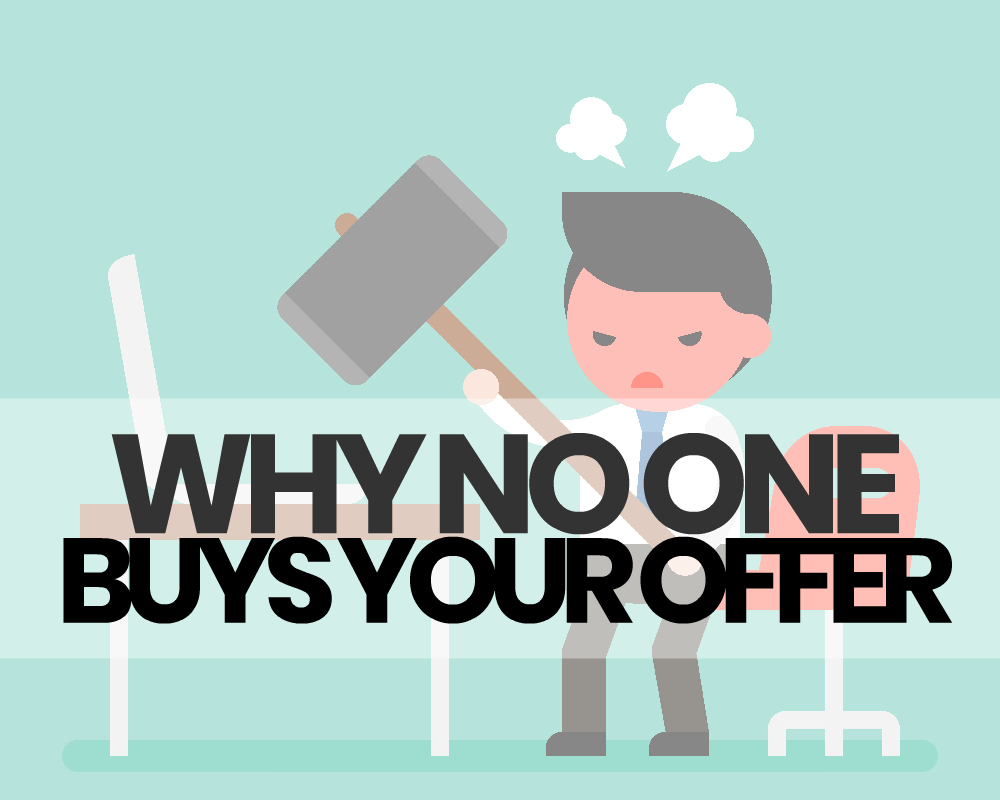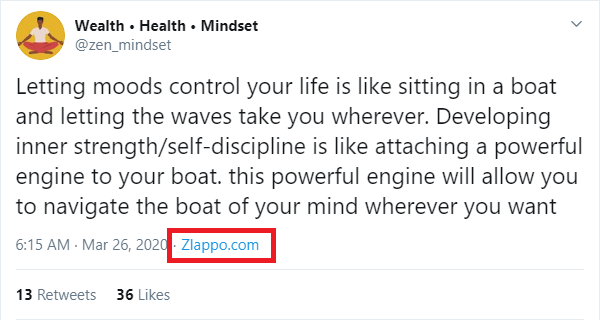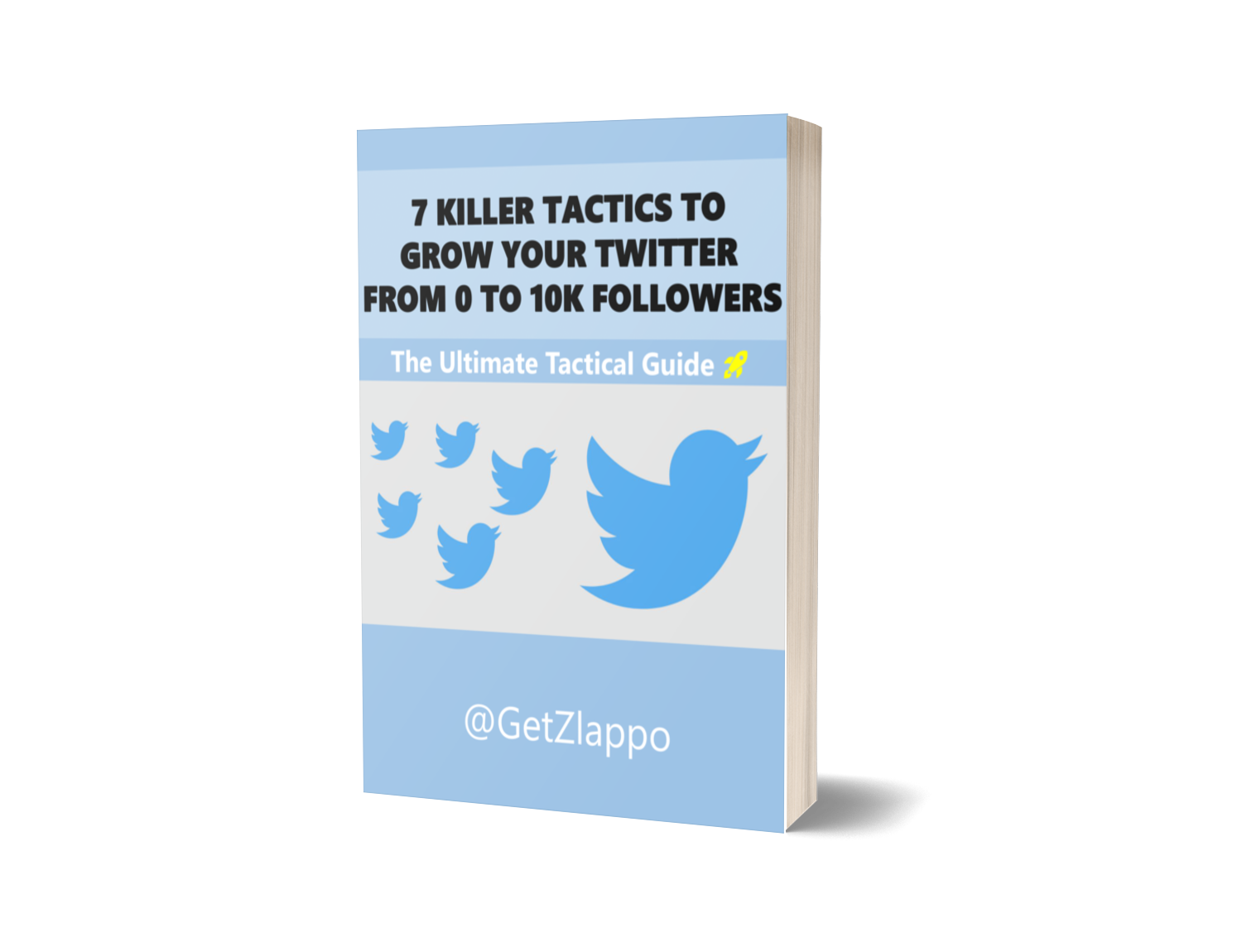
7 Reasons People Aren't Buying Your Offer (and How to Fix It, with Examples)
13 min read jay@zlappo.com Back to Blog
The self-improvement/"make money online" corner of Twitter can be both an inspiring and demoralizing place.
Every other day or so, you see someone announcing how blessed, fortunate, and thankful they are to have hit 1,000 followers in a week or made $2,000 in their first month, and these tweets get so much attention.
And while you congratulate them publicly (like everyone else does), deep down inside you're eating your heart out.
Underneath the veneer of your fake smile and perfunctory happiness for others, you can't deny that you feel like shit.
Questioning your own progress, trying to figure out what you're doing wrong, wondering if you're inferior to everyone else, and just overall doubting yourself.
Well I'm here to tell you don't beat yourself up over it -- we all progress at a different pace, so keep your chin up.
Once you're done being sad, however, let's look at some reasons why your offer isn't selling like hot cakes, and, more importantly, how to fix it:
1. You don't have enough volume.
This is the most obvious reason that no one is buying your offer, so let's get it out of the way first.
Sales is a huge numbers game. If your sales funnel is only sparsely-filled, it's hard to get any sales at the end of the day.
Just picture this simple scenario:
- Out of 10,000 people who see your offer, only 100 might click on it.
- Out of 100 people who click on it, only 20 might make it to the end of your sales letter.
- Out of 20 people who make it to the end of your sales letter, only 1 ends up buying.
And that's if you can get 10,000 people to see your offer to begin with.
That's not easy if you have fewer than 1,000 or even 5,000 followers.
How to fix it
Getting visibility on Twitter is so hard, because it's so crowded and thus easy to get drowned out, but there are certain ways you can growth-hack your follower count, get more views to your profile, and get more retweets if you understand how Twitter dynamics work.
But the main point is this: ALWAYS KEEP THE TOP OF YOUR FUNNEL FULL.
Do it by hook or by crook. DM people, comment on large accounts to get visibility, mention large accounts in hopes of them retweeting you, even try out paid ads, paid reviews, incentivize affiliates handsomely, etc. etc.
There are very few business problems that can't be solved by over-populating the top of your sales funnel. Volume precedes sales.
2. People don't know/like/trust you.
Now, if you have some semblance of volume, and people still generally aren't buying your offer, this will be the next suspect.
Selling on Twitter is very much like selling in real life: people only do business with people they know, like, and TRUST, and, in 2020 -- more so than ever -- it's all about relationship marketing.
This is why I always encourage people to use their real pictures and names; it humanizes you and allows others to relate to you on a personal basis and feel like they're getting to know you very well, just like in real life.
And also, video is very underrated for this purpose.
Here's Sean (@WesternMastery) just showing you his neighborhood from his window in Medellin during the Coronavirus crisis:
Quarantined in Medellín pic.twitter.com/9JyWLDMDRj
— Sean (@WesternMastery) March 21, 2020
And Tanzil ((@TanzilChoudhury) thanking every one of his followers for their support:
Quick message to Twitter fam: pic.twitter.com/ctlybW2jQJ
— Tanzil Choudhury (@TanzilChoudhury) March 26, 2020
It's one of the easiest ways to create an instant connection with others, and I don't understand why more people don't do it.
How to fix it
First, it's crucial to establish close relationships with people on Twitter by being generous and obliging: like people's tweets, retweet their offers, publicly pay them homage, engage with their content, subscribe to their email lists, and just generally be helpful, supportive, and memorable.
People show goodwill when you show goodwill first.
Second, be human. Look like a human, talk like a human, show your human side, ask people about their hopes and dreams, and discuss non-business topics like sports, entertainment, philosophy, or even the present Coronavirus crisis, if you must.
Third, always return the favor when someone has engaged in your content or otherwise supported your business. Don't be a dick.
When the time comes, and you need a shoutout, a mention, a testimonial, a review, or even sales, people are more likely to support you in return. It's Networking 101.
On the other hand, being in "selling mode" perpetually is the best way to get ignored on Twitter. Try it.
I can name so many accounts that do this, and it's obvious they're going nowhere. 😔😔😔
3. You don't have a story.
This is somewhat related to the previous point, but you really have to understand the mindset of customers in this corner of Twitter.
They aren't your mercenary, robotic, perfectly-rational buyers who buy the absolute best in the market.
Otherwise every self-improvement ebook author will get zero sales. Why buy their book over Mark Manson's or Tim Ferriss'?
The question you have to answer is, who the hell are you? What's your backstory? Why should people be emotionally invested in your journey? Why should they root for you?
Are you a regular guy who's tired of being seen as a loser, who's determined to make something out of yourself after being fired from your last job? Or are you a typical parent who just wants to provide the best for your family? Maybe you're a social activist with something to prove and a cause to fight for?
Two influencers come to mind immediately who weave their personal story into their business persona, Ty (@moodyasamother), who is always very public and open about her motherhood:
I don't get why people knock generational wealth.
— Ty @ Moody As A Mother 💘👑💰 (@moodyasamother) March 25, 2020
I plan to get rich & provide a lot for my children.
This doesn't mean I won't instill a good work ethic in them.
They will also be financially literate with the ability to grow their own wealth.
It CAN all exist at once!
And Tweed (@204tweed) as well, who's just a loving father trying to provide the very best for his newborn girl:
My daughter is just shy of 4 months old.
— Ty Tweed 💻💰 (@204tweed) March 12, 2020
She’s at the point where she smiles like crazy as soon as she see’s me.
I cannot describe how amazing this feels, best thing I’ve ever done was have a kid
And I will continue to keep grinding and hustling for her !
Tweed in particular has been growing his account rapidly in a short amount of time, check out his account to see how he gets it right.
How to fix it
People consciously buy products, but people unconsciously buy into stories.
(And if you don't believe me, just see how many mediocre performers get really far on talent shows like America's Got Talent just based on the poignancy of their backstories).
People want to support your journey not necessarily because they like your product, but because they like you as a person.
Not many people talk about this or even realize this. But psychologically, this is how many underdogs/newcomers in the marketplace get a headstart/lift-off in their niche, and they continue to own their unique personal story even as their business grows.
So give people a compelling reason to root for you. Know your audience, tug on their emotional heart strings, speak directly to them and appeal to their inner human decency.
As Dan Lok always says, people don't buy on logic. People buy on emotion, and then justify it later on logic.
4. You lack a marketing shtick.
You're not the only one selling an ebook; every Tom, Dick, and Harry is.
You're not the only one promoting affiliate links; everyone (and their mother) is.
So why would people choose you over the next guy? How are you differentiating, if at all?
Every last influencer on Twitter has a Gumroad product to cram down the throats of their followers, why bother with yours?
How to fix it
The people who do best on Twitter are those who bring something different to the table, not necessarily in terms of a better or even different product, but better and different marketing.
They have a marketing shtick which they absolutely own and defend as a core part of their brand identity.
These people realize that most online offers are so commoditized (because of the low barrier-to-entry of writing an ebook, selling coaching services, selling memberships, or promoting affiliate links) that they have to focus their differentiation muscle on their marketing and branding. That's how they really shine.
They're almost always doing something extra that barely anyone else is that grants them extra credibility and authority, lifting them head and shoulders above the sea of other me-too Twitter influencers out there. EXAMPLES:
Andy (@andyisom100k) is very vocal about the advantages of having a YouTube channel:
Here's what you'll learn from me on Twitter.
— Andy Isom (@andyisom100K) February 11, 2020
📹⬇️⬇️⬇️ pic.twitter.com/iCkxRxx9Eq
YouTube is the FREE stock market.
— Andy Isom (@andyisom100K) March 26, 2020
- Your 💵 compounds every day.
- It’s free to post content.
- The more you have the more it grows.
👇🏼 That’s one video. Daily views. pic.twitter.com/RBUf2ML043
Agustin (@agustinthedev) swears by an email list and advocates relentlessly for Twitter influencers to have a growing email list in tandem with building your social media following, because email simply has better ROI:
Did you already started your Twitter account but you aren't building your email list yet?
— Agustin, the developer 👨💻💰 (@agustinthedev) March 20, 2020
Let me say that you're literally losing money.
Posting your offers using tweets ism't enough, if you want to level up your game, the big money is on your email list. pic.twitter.com/LFmFlYEaBm
Sam (@FiveStarFunnel) denounces direct sales/shouting at a wall on social media, and instead strongly urges everyone to build assets that are naturally magnetic to traffic and sales, like his affiliate marketing blog:
Just start a blog.
— Five Star Funnel (@FiveStarFunnel) March 25, 2020
Write as many posts as you can.
Give as much value in your niche as you can.
Stay consistent, even if 0 people are reading.
Once the snowball starts rolling, it will be more than worth it.
(which, by the way, if you're into affiliate marketing, you should be reading RELIGIOUSLY. I'm not an affiliate marketer, and even I found a lot of the wisdom in his blog an absolute MUST-KNOW.)
The question you have to ask yourself is, what's your shtick?
5. You focus too much on your product quality.
If you think your product quality will be the driving force behind your skyrocketing sales, you haven't been paying attention so far.
Yes, your product needs to be good enough. However, it need not be the best or even close.
There are so many inferior products out there that are completely out of their leagues in terms of the buzz they create and the sales they bring in, so much so that there's a term for it: "overrated."
I'm in the software business, there's a saying that coding is maaaybe 20% of the business, the other 80% is really sales and marketing optimization. Even software is pretty commoditized these days with the rise of no-code tools and coding bootcamps.
With ebooks, coaching, affiliate marketing, and even blogging, it's even worse -- it's so hard precisely because it's so easy.
There's this thing that we all need to acknowledge and constantly try to best, and it's called competition.
How to fix it
Don't sweat over your product too much. If you're writing an ebook, take no more than 2-3 weeks to finish it cover-to-cover.
Spend more time crafting a compelling online persona that's both authoritative and also likable, such that you can even sell ice to eskimos just based on sheer charisma.
Hell, you're better off just creating lots of content on Twitter, plug your offer in the middle of meaty insightful threads (or auto-plug it once your tweet pops off, if you're a sucker for automation), and then let others retweet your content to their followers.
Remember, people show goodwill when you show goodwill first.
There's absolutely nothing wrong with selling once you've provided value first; people expect it even.
So focus the value creation in your marketing.
6. Your social proof is weak.
In 2020, this has to be the biggest reason you aren't making money; I'd bump it up to the top if I could, but I can't without first covering the previous points (which are the fundamentals you must get right before you even attempt to tackle this one).
But the most successful Twitter influencers have created an echo chamber that is populated by a loyal tribe of followers who not only faithfully purchase your offer but will also wax lyrical about how awesome your offer is to everyone else on their own accord.
It's like a marketer's ultimate wet dream.
But this is a chicken-or-egg problem: you can't have social proof before you have a critical mass of customers, and you can't really get a critical mass of customers without convincing social proof.
So how do you deal with this?
How to fix it
What you can do is to manufacture the illusion/image of success: just create buzz, hype, and social proof out of thin air, a la Steve Jobs' reality distortion.
If you don't have any social proof now, it's CRITICAL to rectify this immediately.
Remember again, people want to support your journey not necessarily because they like your product, but because they like you, so capitalize on the people who like you, engage in their content, and let them engage back with your content.
Let them retweet your content, sing praises about your offer, and publicly compliment your product.
Be genuine about it, and only push for this once you honestly believe you have a product worth promoting.
If you can win over just one top influencer (anyone with >50k followers) to say something positive about your offer, you win. Period.
Once uninitiated innocent bystanders see a critical mass of other people liking you, or their favorite influencer liking you, they'll inevitably wonder what the hype is all about, view your offer with a positive bias, and then ultimately hop on the bandwagon themselves to feel accepted and to satiate their FOMO (fear of missing out).
The most recent salient example of the bandwagon effect in action that I've seen is Andy's Affiliate Club:
Members ALREADY making money on DAY ONE!!! #EVERYSINGLEMONTH pic.twitter.com/bDSAEFjnkz
— Andy Isom (@andyisom100K) March 19, 2020
(which by the way is an excellent offer on its own merit, but the marketing is just brilliant.)
Once you've built your tribe, people are willing to promote your offer for you enthusiastically, like 247BEASTMODE (@cfuntanilla) and Chris (@MoneySavvyMind):
BELIEVE THE HYPE!!
— BEAST247MODE (@cfuntanilla) March 26, 2020
People are making crazy money already.
You get paid to connect, market your own work and/or be an affiliate for other creators!💰💰
WIN- WIN SITUATION!
Join the Club!
👇👇👇
(Affiliate)https://t.co/8iKtykNJ1F https://t.co/L6MkdVyaYf
I know a lot of you have heard about the Affiliates Club but what exactly is it?
— Money Savvy Mindset | Chris 💰💸 (@MoneySavvyMind) March 22, 2020
Watch this short video and let the man, the myth, the legend (@andyisom100K) explain it to you!
⬇️
1. Check the vid here 👉🏽 https://t.co/lgo01apvPd
2. Discount waitlist https://t.co/ndBlqIb7if
At the end of the day, it doesn't really matter what your customers think of your product.
It matters more what your customers think other customers think of your product.
Like when I'm building Zlappo, I never found product features to be an effective business differentiator against my closest competitors.
You have feature A, I have feature B, BIG FUCKING DEAL. Nobody cares.
What I've found to be a differentiator is an audience supportive of my venture, who's not only willing to buy my product as a vote of confidence but also promote it to their audience on their own accord:
I tried a bunch of scheduling apps for Twitter
— SELFCONQUERING (@selfconquering) March 14, 2020
Hypefury, Tweetdeck, Hootsuite, you name em.
But @GetZlappo was the best in my book.
Not only is it stupid easy to use, has a ton of features, it works without issues, AND has a mobile app.
See yourself!https://t.co/1dhLvUDBpv
Yeah, I used to use Tweetdeck, but I could never really pick myself up to use it really.
— Five Star Funnel (@FiveStarFunnel) March 25, 2020
With zlappo, it's a lot easier & faster, you can schedule retweets & threads + I like the layout a lot
And, yeah sometimes life just gets in the way. Good that you're back tho bro!
And it spreads from there like the domino effect.
See while people can copy your product, they really can't copy over your loyal supporters. It's hard.
And a loyal tribe is what you should be trying to build, hone, and defend.
7. Your tactics are whack.
This point is pushed down all the way, and it's also the most brief, because relatively it's the least important.
Strategies beat tactics all the time; strategy is the map, tactic is the navigational prowess.
You can have the best navigational skills in the world, but, if you're using the wrong map, you'll never arrive at your destination.
How to fix it
There are 3 easy tactics you can try:
1. Flash sale
Say what you will, but the "25 left," "10 more left," "3 spots left" type of marketing WORKS to create scarcity and urgency, this is Caleb doing his thing (@CalebGregory304):
4 left!!
— Dividend King💰🔥 (@CalebGregory304) March 24, 2020
2. Automation
Almost every successful influencer uses a scheduling/automation/productivity tool to save time and reduce stress.
This is how you know if someone is scheduling their content, e.g. @zen_mindset:

3. Referral/Affiliate marketing
Get people to talk you up like you're a God when they sell your offer on your behalf.
Self-explanatory, I won't go into it too much here.
Pour conclure
What's the biggest takeaway?
Be human. Shore up your credibility with a shtick. Build a loyal tribe who promote on your behalf.
That's it.
/lesson
About the Author

Follow @therealjayber
Let's stay in touch, subscribe to my newsletter! 👇👇👇
Exclusive weekly email on: business musings, personal anecdotes, general self-improvement 💪

